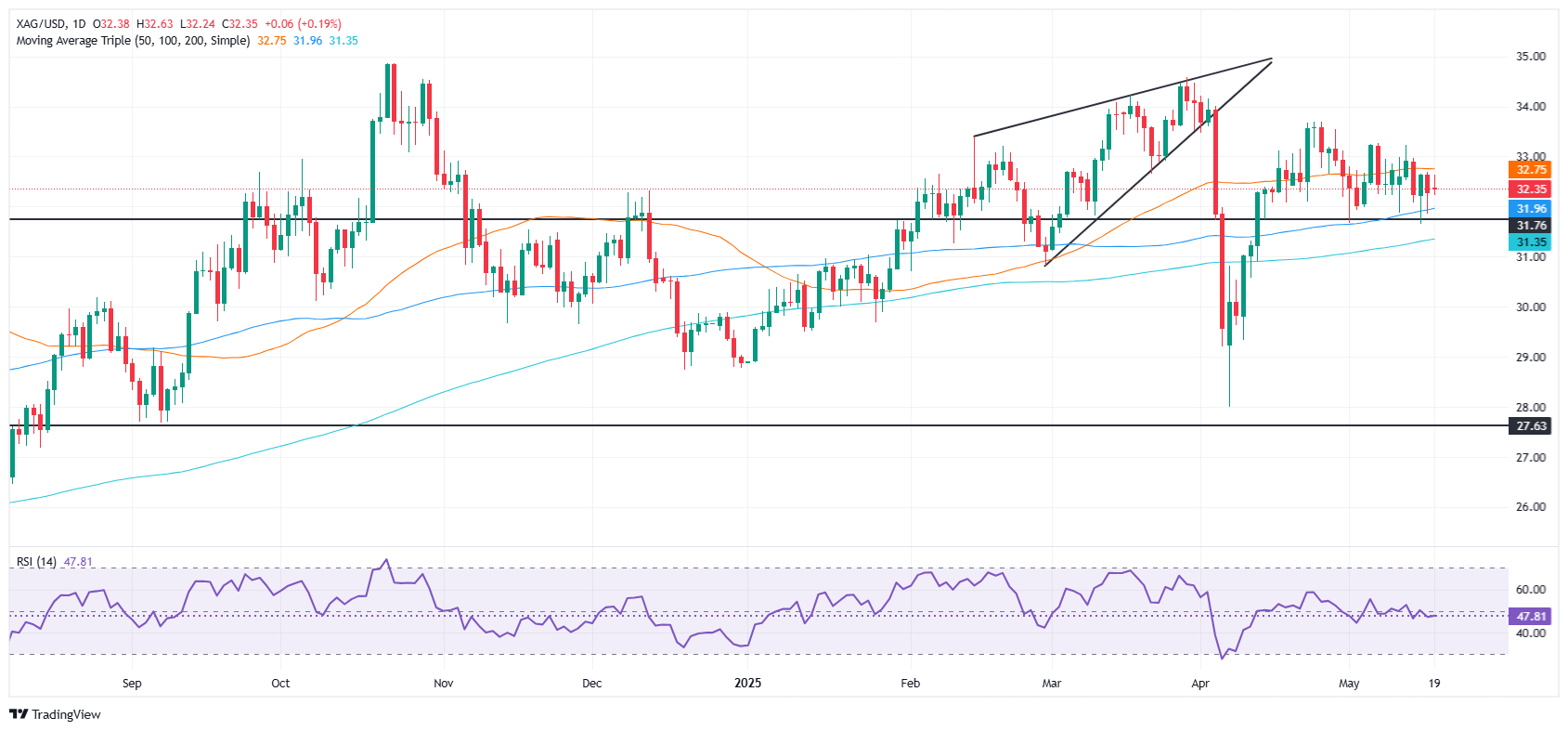- XAG/USD stuck in $31.50–$33.00 range; buyers eye 50-day SMA at $32.73 to regain momentum.
- Moody’s cuts US debt rating to Aa1; DXY drops 0.60% to 100.36, boosting silver’s appeal.
- Key support seen at 100-day SMA near $31.91; breakout or breakdown needed for trend clarity.
Silver price registers modest gains of 0.20% on Monday as US Treasury bond yields edge lower and the US dollar loses ground, as depicted by the US Dollar Index (DXY). The XAG/USD trades at $32.33 after bouncing off daily lows of $32.24.
The DXY, which tracks the dollar’s performance against a basket of currencies, drops 0.60% to 100.36. Moody’s downgrade to US government debt from AAA negative to AA1 stable triggered a US Dollar sell-off, even though US Treasury Secretary Bessent disregarded the news.
XAG/USD Price Forecast: Technical outlook
Consolidation is the name of the game for Silver prices, with neither buyers nor sellers able to clear the top and bottom of the $31.50-$33.00 range.
For buyers to regain control they must clear the 50-day Simple Moving Average (SMA) at $32.73. If surpassed, the next stop would be $33.00, followed by the next cycle high at $33.29, the May 13 peak.
On the downside, the 100-day SMA at $31.91 is the first support level after the strong bounce on May 15.
XAG/USD Price Chart – Daily

Silver FAQs
Silver is a precious metal highly traded among investors. It has been historically used as a store of value and a medium of exchange. Although less popular than Gold, traders may turn to Silver to diversify their investment portfolio, for its intrinsic value or as a potential hedge during high-inflation periods. Investors can buy physical Silver, in coins or in bars, or trade it through vehicles such as Exchange Traded Funds, which track its price on international markets.
Silver prices can move due to a wide range of factors. Geopolitical instability or fears of a deep recession can make Silver price escalate due to its safe-haven status, although to a lesser extent than Gold’s. As a yieldless asset, Silver tends to rise with lower interest rates. Its moves also depend on how the US Dollar (USD) behaves as the asset is priced in dollars (XAG/USD). A strong Dollar tends to keep the price of Silver at bay, whereas a weaker Dollar is likely to propel prices up. Other factors such as investment demand, mining supply – Silver is much more abundant than Gold – and recycling rates can also affect prices.
Silver is widely used in industry, particularly in sectors such as electronics or solar energy, as it has one of the highest electric conductivity of all metals – more than Copper and Gold. A surge in demand can increase prices, while a decline tends to lower them. Dynamics in the US, Chinese and Indian economies can also contribute to price swings: for the US and particularly China, their big industrial sectors use Silver in various processes; in India, consumers’ demand for the precious metal for jewellery also plays a key role in setting prices.
Silver prices tend to follow Gold’s moves. When Gold prices rise, Silver typically follows suit, as their status as safe-haven assets is similar. The Gold/Silver ratio, which shows the number of ounces of Silver needed to equal the value of one ounce of Gold, may help to determine the relative valuation between both metals. Some investors may consider a high ratio as an indicator that Silver is undervalued, or Gold is overvalued. On the contrary, a low ratio might suggest that Gold is undervalued relative to Silver.

